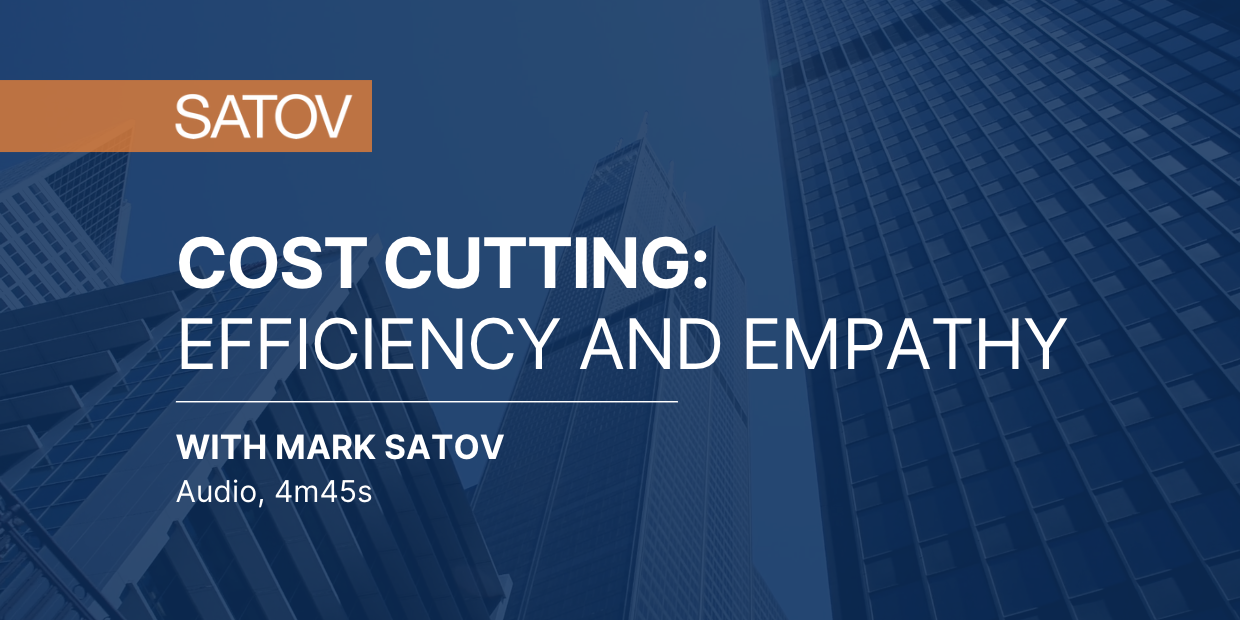Cost cutting: Efficiency and empathy
We discussed cost cutting measures with Mark Satov on a recent call. Mark describes when cost cutting is needed, and the right path to take.
Listen to the discussion or read the transcript below.
Contents
0:00 – Why cost cutting now?
0:51 – Why get an outside perspective?
1:21 – Competition and productivity
2:41 – Post-merger approach
3:12 – The recession
4:00 – Final remarks
Transcript
0:00 – Why cost cutting now?
The economy moves in cycles and people are, unfortunately, very temporal in their areas of focus.
And what you find is that when the economy is booming, people are not always focused on cost efficiency. And then they realize they have to be because the economy is changing direction and credit markets are tightening, and they want to be tight — and so they call and they want to get help on reining in costs.
And to some extent, you could sort of say, well, that’s rational, because you should focus where the biggest upside is, and you may have bigger upside focusing on revenue growth when that’s possible, and have more ability to cut costs when that’s possible, and therefore you should focus there.
But I do find that some companies, some companies, ignore some of the cost efficiencies, and then you create this problem that you have to solve.
0:51 – Why get an outside perspective?
Lucky for us, you know, companies don’t all run perfectly efficiently and so they sometimes need an outside perspective.
And it’s helpful to have an outside perspective on cost specifically, because, you know, you’re making decisions about people’s lives and you want to make them judiciously. And I want to work with clients who are not flip about firing people. They want to consider it carefully, and so they want to be able to look themselves in the eye — and their investors and their employees — and say, hey, we got another opinion on this, and we did a thoughtful and thorough analysis.
1:21 – Competition and productivity
And the truth is that, a lot of people don’t think that cost cutting is nice, and they don’t think that it’s a great business to be in. But we are in a competitive environment. That’s the capitalist system. And unless we’re going to change it, we have to accept that if we have a bloated cost structure, and our competitors take costs out, and they are able to offer the same products or service cheaper than us, they will win.
And it’s not just about who makes more money. If our competitors win, we will be out of business. So the old adage about cutting 100 jobs to save 1,000 is often quite true.
You know you’re not curing cancer, but you are often saving jobs.
And I also believe that an economy that is productive and by productive I mean the productivity is rising or the work per employee is rising, or the output, I should say, per employee is rising is a healthy economy that provides more to its citizens. And sometimes that means that you’re displacing citizens along the way. So I start with all this stuff just because it’s the other side of cost cutting which is it’s unpleasant to disrupt people’s lives. But it has to be done, because that’s what keeps our economy prosperous and what helps us feed our people.
I think, you know, we’ve done it time and time again. We tend to, my opening comment about being temporal, we tend to do it more in periods where the economy is looking shaky.
2:41 – Post-merger approach
You know, I started this business essentially as an ops shop, and we did a lot of supply chain work and it was two big companies coming together and my job, I was an independent consultant when I started, it was just a single shingle shop. And you know, my job was going around and closing factories and warehouses and redesigning the network. And you know, the joke at my client at the time was that if Mark shows up, it’s not necessarily good news for your factory. We don’t know the answers, but there’s at least a question.
And my job was to save costs everywhere by bringing these two businesses together.
3:12 – The recession
And then we did that a few more times and then in 2009, you know, it wasn’t about mergers, it was about survival.
And we did a giant project for a long-time client where we had previously worked on revenue growth, and I said well, we need to take costs out, and it’s sensitive. Because in that case, a lot of that was focused on the call centre and they took pride in giving a white-glove service at the call centre. This wasn’t Rogers, right? This was a high-end call centre, and they needed an outsider to sort of say, hey guys, I know it’s high end, but you could still be more efficient.
And that was the first time where we did a cost savings where we shared the benefit. So we had a low fee — and then our fee went up as the savings went up.
4:00 – Final remarks
I’m not going to be involved in the situation where people are being put on the street in a way that’s irresponsible or unkind. And so it’s comfortable for me to be able to be there and help make those decisions.
And again, you know, we’re doing thoughtful analysis, and we’re trying to be cognizant of the fact that we’re disrupting people’s lives. But we’re going through some economic uncertainty, and they need to be leaned, because they have competitors.
And you know, in a private equity-owned world, if I save somebody $10 million of costs, chances are they’re going to make another $80,000,000 or $100,000,000 bucks when they go sell that thing.
And we get a pretty small cut of that, all things considered. But I’m happy with it.



